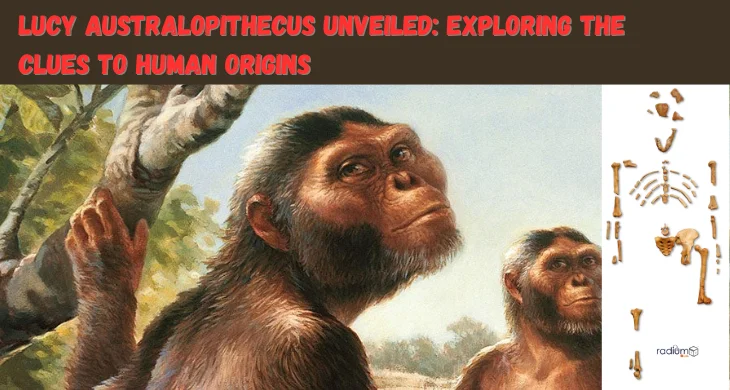Embark on a captivating exploration of “Lucy,” the Australopithecus afarensis fossil that offers crucial insights into our evolutionary past. Delve into the story behind this ancient hominid and unravel the clues that illuminate the fascinating journey of human origins.
Introduction to Lucy
Meet Lucy, a fossilized hominid named Australopithecus afarensis, whose discovery has illuminated the captivating narrative of human evolution. Unearthed in 1974 in Ethiopia, Lucy’s remarkably preserved remains provide a remarkable window into our ancient past. As a member of the Australopithecus genus, her existence bridges the gap between apes and modern humans, offering crucial insights into our evolutionary journey. Lucy’s significance extends beyond her individual identity, influencing how we comprehend the roots of our species. This introduction sets the stage for an exploration of her physical traits, social dynamics, and her profound impact on the field of paleoanthropology.
Fossil Context
Step back in time to the world that Lucy inhabited as an Australopithecus afarensis. Delve into the environmental tapestry of her existence, a mosaic of lush landscapes and diverse ecosystems that spanned roughly 3.2 million years ago. Traverse the terrain of Ethiopia’s Afar region, where she roamed amidst ancient rivers, woodlands, and savannas. By examining her fossil context, we gain a glimpse into the challenges and opportunities that shaped early human life—encountering a world teeming with unfamiliar creatures, fluctuating climates, and evolutionary pressures that would eventually mold the course of human history.
Physical Features
Peel back the layers of time and peer into Lucy’s unique form. Study her fossilized remains to uncover the marvels of her skeletal structure—a testament to her identity as an Australopithecus afarensis. Analyze her distinctive adaptations, such as bipedal locomotion, which allowed her to traverse the ancient terrain on two legs. Delve into her cranial capacity, revealing insights into her brain size and cognitive abilities. Observe the anatomical nuances that set her apart from other species, shedding light on the intricate evolutionary tapestry that led to the emergence of our human lineage.
Walking Tall
Embark on a journey that revolutionized our ancestors’ mode of movement. Delve into the groundbreaking adaptation of bipedalism, as Lucy, an Australopithecus afarensis, took her first steps on two legs. Explore how this transformation from quadrupedal to upright locomotion was a pivotal leap in human evolution. Discover the biomechanical advantages that enabled Lucy to walk tall—freeing her hands for tool use, carrying, and complex tasks. This innovation not only shaped Lucy’s existence but paved the way for the eventual dominance of bipedal hominids, ultimately culminating in the emergence of modern humans.
Diet and Lifestyle
Unlock the secrets of Lucy’s sustenance through the remnants of her teeth and bones. Journey into her dietary choices as an Australopithecus afarensis, deciphering the clues etched in her oral and skeletal record. Examine the wear patterns on her teeth, revealing the plant-based foods that constituted her diet. Probe the composition of her bones to unveil her nutritional history and adaptability. By peering into Lucy’s culinary world, we gain insights into the challenges early humans confronted, painting a vivid picture of their survival strategies amidst the dynamic tapestry of prehistoric ecosystems.
Social Dynamics
Delve into the intricate web of Lucy’s social life as an Australopithecus afarensis. Embark on a journey through time to unravel her interactions within her community, shedding light on her role and relationships. Peer into the early stages of complex social structures that laid the foundation for human societies. Examine evidence of cooperation, communication, and communal living, offering insights into the evolving tapestry of interactions among our ancient ancestors. By deciphering Lucy’s social dynamics, we gain a glimpse into the origins of our social nature and the roots of human connections that continue to shape us today.
Evolutionary Relationships
Embark on a journey through the branches of the human family tree, tracing Lucy’s place as an Australopithecus afarensis. Uncover the intricate connections that link her species to later hominids like Homo erectus and Homo sapiens. Explore the transitions, adaptations, and innovations that paved the way for our modern form. By studying these evolutionary relationships, we decipher the fascinating story of our shared heritage and the remarkable transformations that led from Lucy’s ancient footsteps to the diverse tapestry of humanity today.
Impact on Research
Unveil the seismic impact of Lucy’s revelation on the realm of paleoanthropology. Explore how her discovery, as an Australopithecus afarensis, has upended our understanding of human evolution. Witness the redefining of milestones as Lucy’s ancient bones challenged conventional narratives and ignited debates among experts. Journey through ongoing research, where her legacy continues to fuel inquiry into our origins. Lucy’s emergence as a pivotal ancestor reshaped the very fabric of our understanding, prompting us to unravel the complexities of our past while casting light on the enigmatic path that led to our present state.
FAQ’s
Q1: Who is Lucy?
A1: Lucy, also known as Australopithecus afarensis, is a famous hominid fossil discovered in 1974 in Ethiopia. She is an early ancestor of modern humans, living approximately 3.2 million years ago.
Q2: Why is Lucy significant?
A2: Lucy’s discovery provided crucial insights into human evolution. Her skeletal structure revealed that early hominids walked upright on two legs, a key transition in our evolution. This shift from quadrupedal to bipedal locomotion influenced the development of our species.
Q3: What did Lucy’s bones reveal?
A3: Lucy’s bones showed a mix of ape-like and human-like features. Her pelvis and knee joint indicated bipedalism, while her arms and curved fingers suggested tree-climbing abilities. This combination sheds light on the evolutionary process.
Q4: How did Lucy impact our understanding of human origins?
A4: Lucy’s discovery challenged the notion that large brain size preceded bipedalism. Her fossils highlighted the complex nature of human evolution and the gradual development of traits that define our species.
Q5: What does Lucy’s environment tell us?
A5: Lucy lived in a woodland environment. Her discovery site contained fossils of various animals, plants, and insects, offering insights into the ecosystem she inhabited.
Q6: How was Lucy’s age determined?
A6: Scientists used various dating methods, including studying volcanic ash layers, to estimate Lucy’s age at around 3.2 million years.
Q7: What other Australopithecus fossils have been found?
A7: Besides Lucy, several other Australopithecus fossils have been discovered, contributing to our understanding of human evolution. Notable examples include the Taung Child and the South African “Little Foot.”
conclusion
In conclusion. The remarkable discovery of Lucy. The Australopithecus afarensis has profoundly shaped our understanding of human origins. Lucy fossils have provided invaluable insight into the transition from quadrupedalism to bipedalism. A defining characteristic of our species. Through her skeletal features we’ve gained a glimpse into the complex evolutionary journey that led to modern humans. Lucy’s significance extends beyond her own existence. She represents a bridge connecting us to our distant past, prompting us to question our place in the timeline of life on Earth. As we continue to explore and analyze her remains, Lucy’s legacy continues to inspire curiosity, research & a deeper appreciation for the story of human evolution.




